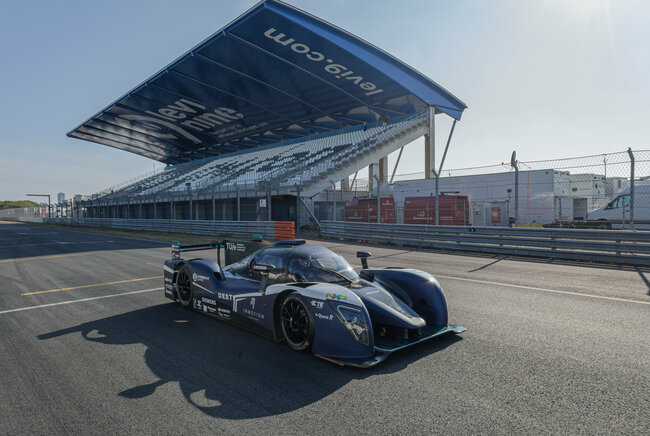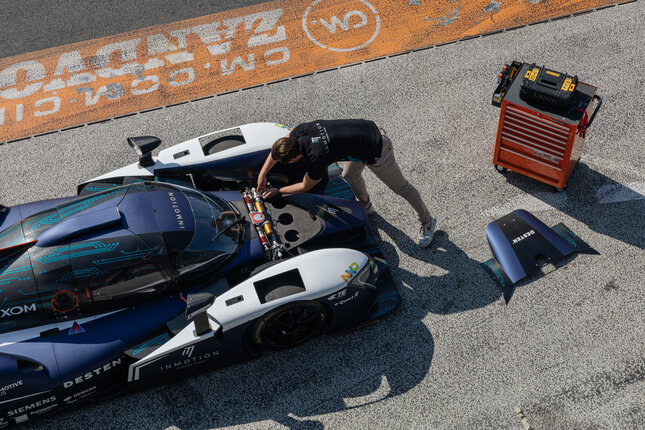InMotion develops fastest-charging electric race car in the world
A 24-hour test showed minimal degradation of the battery pack after fast charging.

Charging an electric race car at the speed of normal refueling? TU/e student team InMotion is getting alarmingly close with the development of the Revolution. The racing monster is capable of fully recharging in less than four minutes, making it the fastest-charging electric race car for long-distance racing in the world, as far as known.
InMotion started designing and producing the new battery pack in the race car with more than thirty students in November 2022. What's remarkable is that this battery pack charges in just 3 minutes and 56 seconds, with a charging power of 322 kW, a total capacity of 29.2 kWh, and a range of approximately 250 kilometers. Reducing the charging time for electric cars is important to make electric driving easier and therefore more accessible for consumers. InMotion has taken up that challenge and is now truly getting close to a pit-stop-worthy charging time.
Innovation: cooling on cell level
During fast charging, a significant amount of heat is generated, leading to accelerated degradation of the battery cells, explains team manager Julia Niemeijer. "In the past, we developed an innovative cooling technology at module level, where cooling plates filled with coolant were placed between the modules containing the cells. This allowed us to extract a lot of heat from the pack. If you want to extract heat as efficiently as possible from the battery pack, you want to cool as close as possible to the battery cells. Therefore, we have developed a method recently that enables cooling at the cell level, with actual coolant flowing between each cell. This means we can extract even more heat from the pack. It has a tremendously positive effect on the lifespan and repeated fast charging. A 24-hour test shows minimal degradation of the battery pack as a result."
Cooling at the cell level is not yet common in the market, which is why InMotion has developed its own modules. Niemeijer: "It was very challenging because there was only a few millimeters of space between the cells in the module to implement the cooling technology. This required us to be extremely precise in our work. We are thrilled that we have found a method that makes this possible."
Inspiration
The goal of InMotion is to demonstrate that it is indeed possible to reduce the charging time of an electric car, to a level comparable to refueling a gasoline car. In doing so, they hope to make electric driving more appealing to consumers and challenge the industry to make the world greener. If a group of highly motivated students can achieve this, then the industry certainly cannot lag behind.
"Student teams like InMotion are important for pushing boundaries and testing new technologies in practice, triggered by challenging applications such as an electric race car. Faster battery charging in an electric car is certainly not trivial. It is crucial for faster market acceptance, where innovations such as a battery pack with highly optimized cooling will play a significant role," says Henk Jan Bergveld, part-time professor of Electrical Engineering at TU/e.

Implementation
The technology has been tested at research institute TNO and Prodrive Technologies. "The beauty of the technology is that it allows for the creation of battery packs in different sizes," explains Stijn van de Werken, Technical Manager at InMotion. "There is often a misconception that smaller battery packs charge faster than larger ones. However, this is not the case. No matter how large you make the pack, the charging time will remain the same as long as the charging station can supply sufficient energy. This opens up numerous possibilities for implementation."
The student team has implemented the technology in an LMP3 race car. The LMP3 is the prototype class of the famous 24 Hours of Le Mans, designed to allow young drivers and new teams to enter the competition. Van de Werken: "We will conduct more extensive testing of the race car on the circuit in the coming year."
The dream
Ultimately, InMotion dreams of showcasing the technology during the 24 Hours of Le Mans, where the battery pack will be tested under the most challenging conditions, namely long-distance racing.
Media contact
Latest news


![[Translate to English:] [Translate to English:]](https://assets.w3.tue.nl/w/fileadmin/_processed_/e/0/csm_BvOF%202019_1031_BHF%20license%20TUe%20ILI%20copy_8a50884392.jpg)